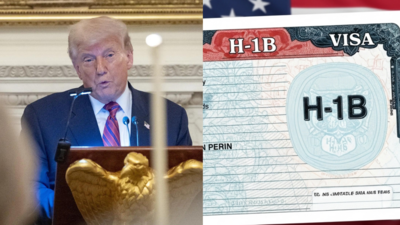Trump admin takes first step towards a wage-linked weighted selection process for H-1B visas | World News

The Trump administration is working on a new rule to create a ‘weighted selection process’ for H-1B cap visas. Weights are likely to be assigned, based on the salary offered to the foreign beneficiary (individual who is being sponsored for the H-1B visa by an American employer).The writing was on the wall. Now it is much clearer. Recently, the Department of Homeland Security (DHS) submitted a proposed rule to the Office of Information and Regulatory Affairs (OIRA), which is the White House office that reviews rules. Post its review, the rule will be published in the Federal Register kicking off the process of implementation of a final rule. The process could take several months as it also involves keeping a window open for inviting public comments and reviewing.“But they are moving fast, so that could happen within the calendar year,” said Doug Rand, a former DHS official.It may be recalled that in early January 2021, with just a few days left for the Biden administration to take charge, the annual H-1B cap lottery process (which was a random selection process) was replaced with a wage-based selection process vide a final rule.Under this, H-1B cap visas were to be allocated according to wage levels, giving priority to those earning the highest salaries in their respective occupations and geographic areas of employment. In effect, the H-1B cap visas were to be awarded first to beneficiaries in Level 4 (which is the highest of the four wage categories and covers very experienced workers), then to those at Level 3, and so on, until the annual quota of 85,000 has been met. This rule was frozen by the Biden administration and subsequently vacated by a court order.The revived proposal by the Trump administration could be similar. Rand points out, “When the US Congress established the H-1B program in 1990 as a temporary work visa for professionals in ‘specialty occupations’, many of today’s occupations didn’t exist. American businesses get no more than 85,000 new H-1B cap slots each year; but the demand is 4-5 times higher.”Indians are major H-1B beneficiaries. For the fiscal ended September 2023, they accounted for 68,825 (58%) of initial employment visas and 2.10 lakh (79%) of extensions, far outpacing China, the second-largest source, with significantly lower allotments of 16,094 and 29,250, respectively. Thus, any change will significantly impact Indians aspiring to work in the US.Rand states that there is a difference between long-term employers (such as MNCs, thousands of startups, small business and community hospitals) and the short-term employers – which could include a handful of unscrupulous staffing companies.“Heedless of this distinction, the Trump administration is about to (re)attempt a major change to the H-1B lottery. It sounds reasonable at first to allocate scarce H-1Bs to the highest-paid workers in each occupation. But, this would be disastrous in practice. Sure, it might force the short-term H-1B employers to either pay their workers more or get out of the business. But the long-term H-1B employers typically hire early-career researchers, engineers, doctors, and other professionals, often fresh out of US graduate school. They may be well-compensated, but they wouldn’t hit the top quartile, so they would be effectively frozen out of the lottery selection process,” explains Rand.Education experts point out that typically international students transitioning to H-1B visas after completing their optional practical training (which is three years for STEM students) are hired at entry levels. Higher wages will make it difficult for companies to hire them. Immigration attorneys also hold the view that it would adversely impact the health sector, scientific research and certain hospital positions.





